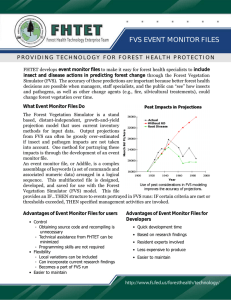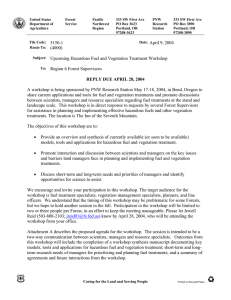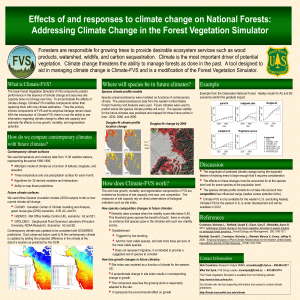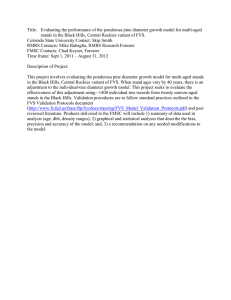RELATIONSHIPS BETWEEN MODELS USED TO ANALYZE FIRE AND FUEL MANAGEMENT ALTERNATIVES
advertisement
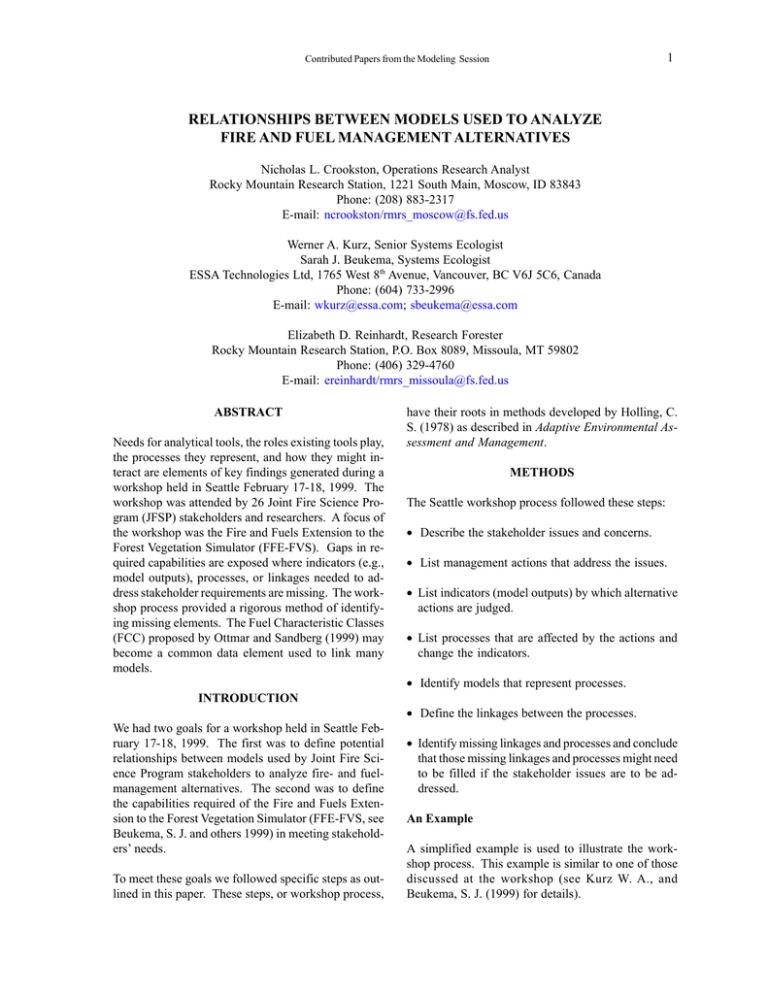
1 Contributed Papers from the Modeling Session RELATIONSHIPS BETWEEN MODELS USED TO ANALYZE FIRE AND FUEL MANAGEMENT ALTERNATIVES Nicholas L. Crookston, Operations Research Analyst Rocky Mountain Research Station, 1221 South Main, Moscow, ID 83843 Phone: (208) 883-2317 E-mail: ncrookston/rmrs_moscow@fs.fed.us Werner A. Kurz, Senior Systems Ecologist Sarah J. Beukema, Systems Ecologist ESSA Technologies Ltd, 1765 West 8th Avenue, Vancouver, BC V6J 5C6, Canada Phone: (604) 733-2996 E-mail: wkurz@essa.com; sbeukema@essa.com Elizabeth D. Reinhardt, Research Forester Rocky Mountain Research Station, P.O. Box 8089, Missoula, MT 59802 Phone: (406) 329-4760 E-mail: ereinhardt/rmrs_missoula@fs.fed.us ABSTRACT Needs for analytical tools, the roles existing tools play, the processes they represent, and how they might interact are elements of key findings generated during a workshop held in Seattle February 17-18, 1999. The workshop was attended by 26 Joint Fire Science Program (JFSP) stakeholders and researchers. A focus of the workshop was the Fire and Fuels Extension to the Forest Vegetation Simulator (FFE-FVS). Gaps in required capabilities are exposed where indicators (e.g., model outputs), processes, or linkages needed to address stakeholder requirements are missing. The workshop process provided a rigorous method of identifying missing elements. The Fuel Characteristic Classes (FCC) proposed by Ottmar and Sandberg (1999) may become a common data element used to link many models. have their roots in methods developed by Holling, C. S. (1978) as described in Adaptive Environmental Assessment and Management. METHODS The Seattle workshop process followed these steps: · Describe the stakeholder issues and concerns. · List management actions that address the issues. · List indicators (model outputs) by which alternative actions are judged. · List processes that are affected by the actions and change the indicators. · Identify models that represent processes. INTRODUCTION · Define the linkages between the processes. We had two goals for a workshop held in Seattle February 17-18, 1999. The first was to define potential relationships between models used by Joint Fire Science Program stakeholders to analyze fire- and fuelmanagement alternatives. The second was to define the capabilities required of the Fire and Fuels Extension to the Forest Vegetation Simulator (FFE-FVS, see Beukema, S. J. and others 1999) in meeting stakeholders’ needs. To meet these goals we followed specific steps as outlined in this paper. These steps, or workshop process, · Identify missing linkages and processes and conclude that those missing linkages and processes might need to be filled if the stakeholder issues are to be addressed. An Example A simplified example is used to illustrate the workshop process. This example is similar to one of those discussed at the workshop (see Kurz W. A., and Beukema, S. J. (1999) for details). 2 The Joint Fire Science Conference and Workshop At issue in this example is the management of an imaginary 10,000 acre area. For this area, managers wish to project the future fire sizes, intensities, and smoke production for each of several management alternatives. The long-term consequences (200 years) of alternatives on forest structure are also needed. Economic indicators are required. The contemplated management actions include fuel and silvicultural treatments arranged in various spatial patterns and locations. Processes that are affected by the management actions and change the indicators include fire spread, fuel consumption, smoke production, fire effects on the dominant vegetation, fuel dynamics, stand dynamics, and socio-economics. Models that represent these processes are: FARSITE (Finney, M. A. 1998) for fire spread, consumption, and smoke production; FOFEM (Reinhardt, E. D. and others 1997) for fire effects; FFE-FVS (Beukema, S. J. and others, these proceedings) for fuel and stand dynamics; and an unidentified economics analysis program that can compute benefits, sum up costs, and compute present net value and soil expectation values so as to provide economic indicators. Organization of the processes into rows and columns provides a tool useful to identify the required linkages between them. The resulting matrix, called a lookingoutward matrix, for this example is illustrated in the center of figure 1. To remind us of the purpose of this linkage of processes, a column listing the indicators (model outputs) is displayed to the right of the matrix. The required inputs are listed to the left. Information flow from the inputs into the matrix is from left to right as is the flow from the matrix to the outputs. Within the matrix, the flow is from a process listed as a row to a process listed as a column. The diagonal elements of the matrix list the model components used to represent the processes and the off-diagonal elements describe the nature of the information that must move from one process to another. Empty off-diagonal elements indicate that no information flow is needed. The information flow within the matrix must be dynamic over time and space and the interactions between processes must be modeled at the appropriate temporal and spatial resolution. Identification of Model Requirements and Missing Links Studying the looking outward matrix reveals some model requirements, missing elements, and missing linkages. To Inputs Digital elev. model, weather From Fire Fire FARSITE Effects Inventory of current vegetation Vegetation Effects Tree species and sizes Economics Activities Mortality and scorch FVS Activities, inventory, and yield Map of forest structure Economic PNV, and benefit/ cost ratio Costs and values Economics Outputs Fire sizes, smoke, intensity Intensity and type FOFEM Fuel loads and types Vegetation Cash flow Figure 1. The looking outward matrix used in the example is in the center surrounded by bold lines. The matrix is flanked by the inputs and outputs that correspond to each component. The diagonal elements name the model used to represent the processes listed as row and column headings in the matrix. The offdiagonal elements show the linkages between processes. Currently, the models shown in the figure do not accomplish this level of interaction, demonstrating a gap in required capabilities. Contributed Papers from the Modeling Session An empty diagonal element indicates that no model exists that can represent the process. In figure 1, we have not identified an economic analysis package to use to provide the economic indicators. That element is the first identified missing component. To work together, the models must be able to serve each other’s needs. These needs become model requirements. In this example, the requirement to feed fuel loads and types from the FVS model to FARSITE illustrates the interaction. Currently, FVS (augmented with the fuel dynamics submodel in the FFE-FVS system) does not provide output in a form that can be used by FARSITE. Furthermore, FFE-FVS operates on a stand spatial resolution and FARSITE operates on a grid resolution. This gap can be filled but it will require an investment. FARSITE outputs are currently not in a form that can be used directly by FOFEM and FOFEM outputs are not in a form that can be used directly by FVS. To overcome the linkage problem between FOFEM and FVS, the two models were coupled within the FFE-FVS system so that they interact dynamically. Another linkage issue between the FVS and FARSITE systems is the temporal scale and resolution. FARSITE is designed to simulate the burning of one fire through time (a few to many days) while FVS uses time steps of about 10 years and FFE-FVS operates at 1 year intervals. This example serves to illustrate how an analysis of needs can be organized to provide a rigorous study of model and system requirements and to identify missing linkages. However, the strength of the conclusions depends on whether the choice of issues was sufficiently comprehensive and the choice of indicators was truly relevant to the decisions addressing those issues. In this example we made the assumption that managers and scientists present at the workshop outlined real management concerns, identified indicators that are relevant to making decisions, and listed processes that encompass the effects of proposed management actions. 3 are addressed by considering the results of smaller scaled analyses. At the airshed level, the issues center on smoke production and dispersion. Short-term issues about the timing of prescribed fires (shall we start the fire this morning or tomorrow?), their impact on smoke content of an airshed, and so on, require high resolution smoke emission and dispersion models. Long term issues imply consideration of vegetation dynamics and the risks and impacts of alternative managed wildfire regimes. Landscape-level issues often include questions such as these: · How does the hazard or risk of fire change over time? · What management regimes are required to reduce wildfire risk? · What is the benefit/cost ratio of each managment regime? · What are the implications of fuel management activities on other resources including wildlife? · What will the pattern of fire spread be for each management alternative? · How will fires alter the mosaic of forest structure and function? These issues require longer temporal scope than identified at the airshed level. They are similar to those expressed in the example and imply the need for a modeling framework similar to the one illustrated in figure 1. Stand-level issues would include questions such as these: · How will the stand structure and function change with different fire return intervals? SEATTLE WORKSHOP RESULTS Spatial Scopes and Issues The workshop considered issues at four spatial scopes: national, airshed, landscape, and stand. National scale issues are typically concerned with regional budget allocations and national fuel treatment program justification. Workshop participants decided that decisions at the national scale involving quantitative analyses · What management regimes can be used to keep the stand healthy and less vulnerable to catastrophic changes due to fire or other disturbances? · What are the interactions of fire and other agents like insects and diseases? Some of the landscape-level issues are also stand-level issues. Long-term analyses that include many detailed 4 The Joint Fire Science Conference and Workshop ecosystem processes are needed to address these issues. to several conclusions. These, plus conclusions reached since the workshop, follow. Processes Considered and Models Identified Regarding FFE-FVS Participants identified a list of processes and some models that represent those processes. In some cases, more than one model is designed to represent the same process and in other cases no model exists that represents the process. The list is summarized in the form of a looking outward matrix illustrated in figure 2. Numbers are used to identify the models and letters are used to identify the processes they represent (table 1). Models are listed in the diagonal elements and additionally in off-diagonal elements when they provide linkages between processes. Processes that have no representative model and required missing linkages are shown by dark shading, while unshaded elements imply that no linkage is required. Workshop participants recognized the ability of FFEFVS to link vegetation dynamics and management actions to fuels, fire, and fire effects at the stand level. Because the model can be easily run for numerous stands, it was identified as being well suited to address several issues at the stand and small landscape level. There is a strong demand for FFE-FVS in several geographic regions. Currently, the FFE extension of FVS is calibrated only for the Inland Northwest. Calibration for parts of northern California and southern Oregon is under way. Funding is in place to provide variants to most of the rest of the western United States. Linkages between FVS extensions that represent insect and diseases and the FFE-FVS need to be modified to operate on annual time steps. Funding to fill this need is also in place. Workshop Conclusions Studying the looking outward matrices in the workshop report (Kurz, W. A. and Beukema, S. J. 1999) led To From A A-Initialize 1 B C D E D-Disturbances 2 2 E-Overstory 2 2,3 F G H I J 2 2 2 2 2 2 2 2 2 2,4 4 K L M N O P B-Understory C-Organic soil F-Snags 2 G-Fuel H-Behavior I-Consumption 2 2 2 2,3,4 L-Emissions M-Dispersion 3 2,3 J-Effects K-Spread 2 4 4 4 3,4,5 6 6 N-Ignition O-Treatment P-Economics ? Figure 2. A looking outward matrix that references the processes and models discussed at the Seattle workshop (modified from Kurz and Beukema 1999). Dark shaded elements show linkages that are needed but missing, light shaded elements show that some linkages exist or are likely. The economics model has not been identified. 5 Contributed Papers from the Modeling Session Id Process A Initialization (current conditions) Id Model/Notes 1 FCC’s (plus vegetation and other fuel inventories) B Understory dynamics (forbs, shrubs, grasses) None identified C Organic soil dynamics None identified D Insects, diseases, and other non-fire disturbances 2 FVS extensions for some selected pests and diseases (Tech and others 1976) exist but are currently not completely integrated into FFE-FVS. E Overstory vegetation dynamics 2 Base FVS (Wykoff and others 1982) linked to FFE-FVS F Snag dynamics including snag management 2 FFE-FVS G Surface fuel dynamics including fuel management 2 FFE-FVS H Fire behavior 2 BEHAVE (Andrews 1986) as included in FFE-FVS I Fuel consumption 3 FOFEM (Reinhardt and others 1997), or Consume (Ottmar and others 1993) J Fire-caused vegetation damage and mortality 3 FOFEM, Consume, or FETM (Wiitala ???) K Fire spread 4 FARSITE (Finney 1998) L Smoke emissions 5 EPM (Sandberg 1984) M Smoke dispersion 6 An unidentified dispersal model N Ignition O Treatment costs estimates None identified 7 None identified P Economic analyses of alternatives None identified Table 1. Processes and corresponding models used to represent those processes. The identification letters and numbers are used in figure 2 to show the relationships between models. FVS could use the FCCs both to initialize fuels and as a tool for communicating fuel types and loads between other models. Integration of FCCs into FFE-FVS has started since the Seattle workshop. The representation of non-tree vegetation in most FVS variants needs to be improved. The present method is to estimate non-tree vegetation fuel loadings by implying the loads inherent in the standard fuel model selected to represent the stand’s fuels. The selection depends on the stand location, potential vegetation, and current overstory vegetation. We are concerned that these methods will not provide acceptable model behavior where non-tree vegetation is an important factor driving fire behavior and effects. This need will be addressed as we work on the calibration of variants covering central California and central Rocky Mountains. We have concluded that FFE-FVS should only be used to represent ecosystems where trees are the dominant potential vegetation. Other models should be used to represent shrub- and grass-lands. FFE-FVS’s ability to interact with FOFEM and Behave required closely coupling these models. FVS does not provide facilities that would allow it to work dynamically with models that are not closely coupled. Providing better capabilities within FVS so that it can be used cooperatively with other models has become an important goal and would likely be necessary for FVS to be dynamically linked with FARSITE. Regarding Other Models Many processes identified at the workshop are represented by more than one model. In some cases, competing models were identified that address the same issues at about the same scale. In all cases, representing these processes is necessary to address the full range of stakeholder issues identified. Beyond the linkages inherent within FFE-FVS, many of the desirable linkages are missing. Building these linkages is a primary need. Exactly which linkages are worth building and how to implement their construction are issues that need fur- 6 The Joint Fire Science Conference and Workshop ther consideration. Another workshop is being planned to provide guidance to the JFSP board stakeholders on this subject. The new workshop will necessarily require broader participation than that afforded by the Seattle workshop, and it needs to focus on the full range of stakeholder concerns without emphasis being placed a specific model. SUMMARY Several of the decision support needs identified by the JFSP stakeholders at the workshop involve the analysis of trade-offs over a range of time and space scales that are not readily addressed by any single model. While individual models represent specific components and processes that need to be analyzed, the decision support needs cannot be addressed without linkages between or integration of several models. The FFEFVS provides an example of the successful integration of existing models into an analytical tool that addresses important JFSP decision needs. For other issues, establishing simple linkages between models may suffice. The process described here could be applied to identify the remaining needs and the primary gaps. This information can then assist in focusing the development and linkage of models that will best serve the JFSP stakeholder decision support needs. ACKNOWLEDGMENTS We thank Albert R. Stage and Dennis Ferguson for helpful review comments. REFERENCES Andrews, P. L. (1986). BEHAVE: Fire behavior prediction and fuel modeling system - BURN subsystem, Part 1. General Technical Report INT-194. Ogden, UT: U. S. Department of Agriculture, Forest Service, Intermountain Research Station. 130 p. Beukema, Sarah; Reinhardt, Elizabeth D.; Kurz, Werner A.; Crookston, Nicholas L. (1999). An overview of the fire and fuels extension to the forest vegetation simulator. <<these proceedings>>. Finney, Mark A. (1998). FARSITE: Fire area simulator–Model development and evaluation. Research Paper RMRS-RP-4. Ogden, UT: U. S. Department of Agriculture, Forest Service, Rocky Mountain Research Station. Holling, C. S. (ed.). (1978). Adaptive Environmental Assessment and Management. Chichester: John Wiley & Sons. 377 p. Kurz, Werner A.; Beukema, Sarah J. (1999). Decision support needs of JFSP stakeholders and the role of th efire and fuel extension to FVS. Draft report prepared by ESSA Technologies Ltd., Vancouver, B. C. 57 p. Ottmar, Roger D.; Burns, Mary F.; Hanson, Aaron D.; Hall, Janet N. (1993). CONSUME user’s guide. General Technical Report PNW-GTR-304. Portland, OR: USDA, Forest Service, Pacific Northwest Research Station. 119 p. Ottmar, Roger D.; Sandberg, David V. (1999). Characterizing fuels into the 21st century. <<these proceedings>> Reinhardt, E. D.; Kean, R. E.; Scott, J. H. (1997). First order fire effects model: FOFEM 4.0, user’s guide. General Technical Report INT-344. Ogden, UT: U. S. Department of Agriculture, Forest Service, Intermountain Research Station. 65 p. Sandberg, D. V. and Peterson, J. (1984). A source strength model for prescribed fires in coniferous logging slash. Paper presented at the 1984 annual meeting, Air Pollution Control Association, Pacific Northwest Section, 1984 November 12-14; Portland, OR. 10 p. Teck, R. M.; Moeur, M.; Eav, B. (1996). Forecasting ecosystems with the Forest Vegetation Simulator. Journal of Forestry 94(12):7-10. Wykoff, William. R.; Crookston, Nicholas L.; Stage, Albert R. (1982). User’s guide to the Stand Prognosis Model. Gen. Tech. Rep. INT-133. Ogden UT: U. S. Department of Agriculture, Forest Service, Intermountain Forest and Range Experiment Station. 112 p.
